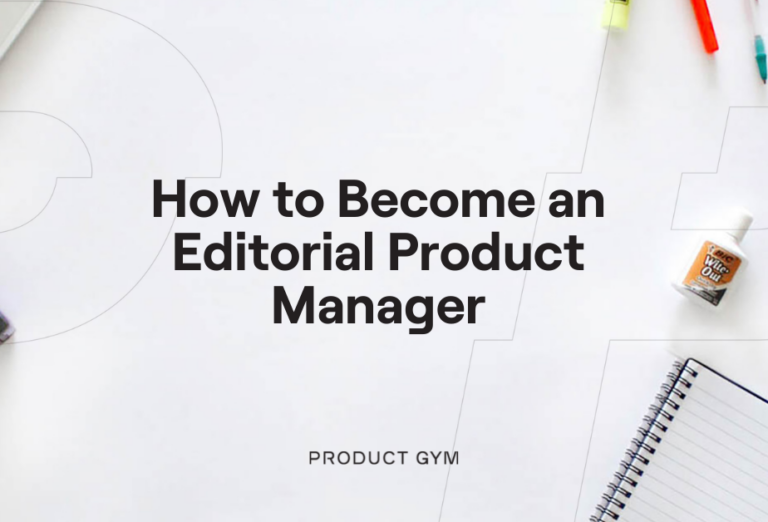The business of publishing is changing, and fast. Gone are the days when organizations’ approach to being “digital” was hiring an IT guy to put articles online. Today’s cut-throat environment is challenging even the most established publishers to change the way they reach their audience. The word “product” in the editorial context now means more than the features and stories published. As companies commit to a digital culture of innovation, the Editorial Product Manager is more essential than ever.
To be a great Editorial Product Manager (also called the Content Product Manager), you’ll need a different set of skills than a traditional reporter or editor. But if your background is in journalism or digital content, this could be an excellent path for your transition into product management.
Not sure what we’re talking about? Keep reading; you’re in the right place.
Product Management in Media?
Before we dive into it, let’s take a look at the growing need for product management in media. Here’s why we think it’s a great opportunity for aspiring and experienced PMs alike.
Traditional publishing products would refer simply to things like books, newspapers, magazines, or television and radio broadcasts. But the internet and digital economy democratized the way people could reach an audience, and suddenly publishing juggernauts were faced with one reality: Evolve or die.
Traditional publishing products would refer simply to things like books, newspapers, magazines, or television and radio broadcasts. But the internet and digital economy democratized the way people could reach an audience, and suddenly publishing juggernauts were faced with one reality: Evolve or die.
In looking for ways to leverage their connections and resources, the term “digital product” in publishing has come to encompass a wide range of tools and applications — all created to inform, entertain, or notify readers.
Examples of Content Product Management
You’ve likely come across and interacted with many of them. Some successful publishing products that have arisen as a result of “product thinking” include:
- The NYT Cooking app — a digital cookbook and cooking guide by The New York Times informed by the longstanding popularity of The Times’ recipes.
- The Quartz app that connects readers with news and facilitates a conversation through interactive stories.
- The Political Ad Collector extension — a crowdsourcing tool created by ProPublica to monitor online political advertising for increased transparency and accountability during elections.
Like all popular products, the above were created to fulfill an existing need in the market. Their popularity demonstrates this — The NYT Cooking app gained 120,000 subscribers in just 1.5 years.
It’s success stories like these that have influenced a product management mindset in both established and start-up publishing companies. Bloomberg, The Washington Post, Vox Media, and many others are increasingly hiring Product Managers to help them bridge the gap between journalism and technology.
This can only mean more opportunities for you, the aspiring editorial PM.
What Does an Editorial Product Manager Do?
Digital products provide new avenues for companies to reach their audience and distribute information. For example, one media company may distribute its content across websites, video distribution platforms, and several apps, with subscription options for some or all of these channels. The Product Manager’s job is to integrate journalism with user experience, software engineering, and data analytics to come up with a digital product that will be useful to the audience and profitable to the company.
But while a Software Engineer or UX Designer mainly considers the technology used to create and distribute the content to be the product, a Content Product Manager understands that the content itself is essential to successful innovation. Thus, they are responsible not only for coming up with new technology but improving the content and how it is curated too.
Editorial Product Management Responsibilities
To achieve this, an Editorial Product Manager will have their hands in:
- Setting content and product strategy.
- Identifying and evaluating new opportunities to drive business goals.
- Prioritizing what content to produce and what products to build to support new and existing content.
- Executing high-quality and valuable content and well-designed products.
These are the high-level responsibilities of the job. But like most other positions, Product Manager roles and responsibilities differ across the industry. For example, the job description of a Content Product Manager in an academic publishing company will differ from one in a digital publishing company.
Similarly, the size of the company you work with greatly determines the tasks of the job. For example, the Washington Post has tripled the number of Product Managers it employs in the past few years, attaching one to every single internal and external project it operates. The responsibilities you would take on in such a company would be much more specialized than if you were the sole Product Manager at a startup.
How Career Coaching Can Help You Become an Editorial Product Manager
At Product Gym, our career coaches apply a simple four-step framework to land our members the Product Manager job they’re looking for. With this structure and the support of the PG community, both aspiring and veteran PMs have increased the number of calls they receive for interviews. The process also leads to more interviews converted into offers.
Here’s how the magic works:
1. Optimize
From the best techniques for writing a cover letter to building an attractive Product Manager resume, the first step our coaches focus on boosting your credibility and professional branding. We’ll help you optimize your application with:
- A resume designed to beat the ATS
- A cover letter that shows your culture fit
- An optimized LinkedIn profile that aligns with the above
- A 30-second personal pitch that sells you as the best possible candidate
At Product Gym, we provide branding workshops, resume reviews, and the tools you need to take your professional branding to the next level.
2. Apply
Product Gym members apply for 20+ Product Manager jobs weekly, and often average 9+ interviews in any given week. By perfecting your application strategy and interview approach through practice and experience, you’ll build the confidence and expertise you need to wow the recruiter and interviewers at your dream company when the time comes.
Of course, our tried and tested application framework is paired with tools, tips, and interview support that all come together to form a job-hunting strategy that really works. And our coaches are with you every step of the way.
3. Convert
Once you’ve lined up your interviews, it’s time to zero in on converting those round ones into round twos, and so on, all the way to the Editorial Product Manager job offer. It’s no secret that our coaches focus on the Product Manager interview process here at Product Gym: we’re there to help our members learn how to ace every step and every question — including behavioral questions, technical questions, case studies, salary negotiation, and more.
4. Learn
When should you start building your product management skillset? Before you apply? When you’re on the job? Honestly, transitioning into product management can be a long journey. We encourage Product Managers (whether you’re a first-timer or an industry vet) to start learning at the beginning and continue on past the finish line.
You likely already have skills that translate well into a Product Manager role: keep sharpening them, and find the gaps where you can learn, grow, and practice new skills to become a better Product Manager every day.
We want to make sure our members show up skilled and prepared for their interviews and their first day on the job, which is why we offer 20+ technical and business courses taught by industry experts.
Skills Needed to Become a Product Manager in Publishing
So what skills do you need in your toolkit to deliver on the above? We’ll group them into two: Specific and general skills.
The key components a good Product Manager in publishing needs to have include:
Journalism Skills
Digital products open up numerous storytelling possibilities and it takes a journalistic mind to spot them. At the same time, because the speedy distribution of these stories is key, a PM with experience in production and publishing better understands the organizational culture of media and how to leverage it. In fact, companies like Vox Media prefer their team’s PMs to come from a journalism background.
Design Thinking
In the same way that a reporter would write a story with the reader in mind, the PM needs to employ design thinking in the products created. They need to understand how technology and its use will affect content. That is, how it will be rendered on different devices, how it will be presented in a push notification, how the customer will interact with it, and other such user experience considerations.
Technology Skills
While a PM doesn’t have to have software programming or UX design skills, a strong technology understanding facilitates good communication across these key functions of production. You should have a strong enough grasp of these concepts to be able to communicate effectively with different team members, even the technical.
Data Analytics Skills
Any successful product is informed by data, and more so with publishing. Rigorous research and data are critical to identifying what the audience wants. It is also the most effective way of understanding how they are interacting with a product. Media companies have access to a lot of customer data, and they need a PM who can help them interpret it.
Need-to-Have Product Management Skills
Aside from the above “product management digital content” skills, there are also the general skills that every good PM must have:
- Business acumen: A content PM should help a company accomplish not only its editorial goals but also its financial goals. Understanding the context and activity of the business is a must.
- Prototyping: Visual aids are important, especially when trying to convey the plan and future of your product to various stakeholders.
- Problem-solving: Product Managers are expected to find creative solutions to problems and find new approaches to solving users’ needs.
- Communication: A Product Manager must be able to communicate effectively with multiple teams and stakeholders.
- Leadership: PMs are not called mini-CEOs for nothing. They are responsible for getting the company to the goal through the products they represent.
- Empathy: Not only does empathy increase customer satisfaction and loyalty, it’s an integral part of innovation. Delivering products that captivate customers starts with getting to the heart of what they really want.
Check out this video for a better idea of what skills you can develop to crush the job hunt:
Editorial Product Manager Job Description
As mentioned above, organizations have different product and company goals. That means the qualifications and qualities they seek out will differ.
Let’s take a look at an example of an Editorial Product Manager job description in an academic publishing house:
We have a fabulous opportunity to work for a global cutting-edge and forward-thinking publisher of academic books and journals for an experienced and innovative Books Product Manager. The Product Manager will oversee the end-to-end processes underlying the innovation of the organization’s books (all formats), steering the product life-cycle from commissioning through to the user.
Reporting to a senior manager, the Books Product Manager will work in close collaboration with colleagues within Publishing, Marketing, Sales, Content Management, Business & Product Innovation, and other internal stakeholders and business partners
Books Product Manager Responsibilities:
- Driving sales and contributing to the development of go-to-market strategies through performance monitoring, segment and market analysis, plus, analysis of competing products.
- Conducting research, detecting, and advising on market trends that influence the company’s position in the online book solutions market.
- Providing critical input to both content and product development based on market and customer insight.
We are looking for a candidate who is/has:
- Proven relevant experience in sales or market development for online product solutions.
- Experience in market and consumer research.
- Proven ability to influence cross-functional teams without formal authority and experience in stakeholder management.
- Commercially focused with a high level of business acumen and strong interpersonal skills.
- Results-driven and forward-looking.
- Good understanding of innovations underway in the academic book world and able to multi-task between different activities and priorities
While this may be an academic Product Manager position, it’s easy to tell the skills we highlighted in the section above are necessary across the board. Expect any product management digital content job description to list out similar requirements.
How to Become a Product Manager in Publishing
Publishing may be a whole different world from FAANG and other tech companies, but the good news is the steps to success remain the same when it comes to applying.
If you have a background in journalism and other relevant experience and would like to get into product management, here’s what you should do:
1. Do Your Research
You must be in the know when it comes to the state of the industry, as well as the jargon that accompanies it. If you’re looking into a specific company, look up recent announcements, news, and history around their product. But even before we get to interviewing stage, it is key for the next step…
2. Revamp Your Resume
Your resume must be relevant to the position you are applying for, so you must be familiar with the industry and include the role’s responsibilities and requirements in it. Check out our resume writing guide as well as our free webinar course on how to synchronize your resume and your LinkedIn profile.
3. Optimize Your LinkedIn
Speaking of LinkedIn, this is a prerequisite for any Product Manager, especially with many companies now using headhunting techniques instead of traditional job advertising. Ensure that you have your LinkedIn optimized with relevant experience and the skills you’ve obtained.
4. Prepare Your Personal Pitch
This is your personal elevator pitch: It should outline your background in the best possible way to lean into the Editorial Product Manager position’s key responsibilities.
5. Apply!
Once you have your branding assets ready to go (hint: that’s your LinkedIn profile and killer resume), it’s time to take the plunge. Most companies will post job openings on their site: apply directly this way rather than through job search platforms to improve your chances. Recruiters are more likely to look at those applications before skimming through third-party sites.
Keep in mind that the traditional way of applying for jobs is changing. As mentioned above, headhunting is becoming more and more popular. Therefore, you might want to consider networking your way into a job:
6. Practice for Common Interview Questions
As with other Product Manager roles, there will be four stages of the interview process to become an Editorial Product Manager:
- First-round screening call with a Recruiter
- Second-round with the Hiring Manager or Product lead
- Third-round interview with multiple stakeholders
- Fourth-round: typically a case study
Make sure that you’re well-versed in the most common technical, behavioral, and data analysis interview questions.
Start Your Editorial Product Manager Job Hunt
Need some more help with getting your job strategy right? We’ve got your back! Get in touch with our admissions team and learn how Product Gym can help you transition into the PM role of your dreams.




